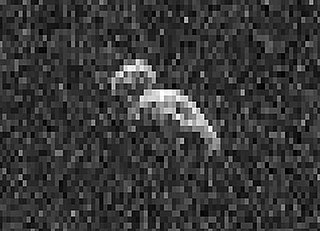
An asteroid is a minor planet—an object that is neither a true planet nor a comet—that orbits within the inner Solar System. They are rocky, metallic, or icy bodies with no atmosphere. The size and shape of asteroids vary significantly, ranging from small rubble piles under a kilometer across to Ceres, a dwarf planet almost 1000 km in diameter.

A near-Earth object (NEO) is any small Solar System body orbiting the Sun whose closest approach to the Sun (perihelion) is less than 1.3 times the Earth–Sun distance. This definition applies to the object's orbit around the Sun, rather than its current position, thus an object with such an orbit is considered an NEO even at times when it is far from making a close approach of Earth. If an NEO's orbit crosses the Earth's orbit, and the object is larger than 140 meters (460 ft) across, it is considered a potentially hazardous object (PHO). Most known PHOs and NEOs are asteroids, but about 0.35% are comets.

A meteoroid is a small rocky or metallic body in outer space. Meteoroids are distinguished as objects significantly smaller than asteroids, ranging in size from grains to objects up to a meter wide. Objects smaller than meteoroids are classified as micrometeoroids or space dust. Many are fragments from comets or asteroids, whereas others are collision impact debris ejected from bodies such as the Moon or Mars.

An impact event is a collision between astronomical objects causing measurable effects. Impact events have been found to regularly occur in planetary systems, though the most frequent involve asteroids, comets or meteoroids and have minimal effect. When large objects impact terrestrial planets such as the Earth, there can be significant physical and biospheric consequences, as the impacting body is usually traveling at several kilometres a second, though atmospheres mitigate many surface impacts through atmospheric entry. Impact craters and structures are dominant landforms on many of the Solar System's solid objects and present the strongest empirical evidence for their frequency and scale.

Asteroid impact avoidance comprises the methods by which near-Earth objects (NEO) on a potential collision course with Earth could be diverted away, preventing destructive impact events. An impact by a sufficiently large asteroid or other NEOs would cause, depending on its impact location, massive tsunamis or multiple firestorms, and an impact winter caused by the sunlight-blocking effect of large quantities of pulverized rock dust and other debris placed into the stratosphere. A collision 66 million years ago between the Earth and an object approximately 10 kilometers wide is thought to have produced the Chicxulub crater and triggered the Cretaceous–Paleogene extinction event that is understood by the scientific community to have caused the extinction of all non-avian dinosaurs.

Eugene Merle Shoemaker was an American geologist. He co-discovered Comet Shoemaker–Levy 9 with his wife Carolyn S. Shoemaker and David H. Levy. This comet hit Jupiter in July 1994: the impact was televised around the world. Shoemaker also studied terrestrial craters, such as Barringer Meteor Crater in Arizona, and along with Edward Chao provided the first conclusive evidence of its origin as an impact crater. He was also the first director of the United States Geological Survey's Astrogeology Research Program.

The B612 Foundation is a private nonprofit foundation headquartered in Mill Valley, California, United States, dedicated to planetary science and planetary defense against asteroids and other near-Earth object (NEO) impacts. It is led mainly by scientists, former astronauts and engineers from the Institute for Advanced Study, Southwest Research Institute, Stanford University, NASA and the space industry.
Near-Earth Asteroid Tracking (NEAT) was a program run by NASA and the Jet Propulsion Laboratory, surveying the sky for near-Earth objects. NEAT was conducted from December 1995 until April 2007, at GEODSS on Hawaii, as well as at Palomar Observatory in California. With the discovery of more than 40 thousand minor planets, NEAT has been one of the most successful programs in this field, comparable to the Catalina Sky Survey, LONEOS and Mount Lemmon Survey.

Catalina Sky Survey is an astronomical survey to discover comets and asteroids. It is conducted at the Steward Observatory's Catalina Station, located near Tucson, Arizona, in the United States.

The Panoramic Survey Telescope and Rapid Response System located at Haleakala Observatory, Hawaii, US, consists of astronomical cameras, telescopes and a computing facility that is surveying the sky for moving or variable objects on a continual basis, and also producing accurate astrometry and photometry of already-detected objects. In January 2019 the second Pan-STARRS data release was announced. At 1.6 petabytes, it is the largest volume of astronomical data ever released.

Petrus Matheus Marie (Peter) Jenniskens is a Dutch-American astronomer and a senior research scientist at the Carl Sagan Center of the SETI Institute and at NASA Ames Research Center. He is an expert on meteor showers, and wrote the book Meteor Showers and their Parent Comets, published in 2006 and Atlas of Earth’s Meteor Showers, published in 2023. He is past president of Commission 22 of the International Astronomical Union (2012–2015) and was chair of the Working Group on Meteor Shower Nomenclature (2006–2012) after it was first established. Asteroid 42981 Jenniskens is named in his honor.
2007 WD5 is an Apollo asteroid some 50 m (160 ft) in diameter and a Mars-crosser asteroid first observed on 20 November 2007, by Andrea Boattini of the Catalina Sky Survey. Early observations of 2007 WD5 caused excitement amongst the scientific community when it was estimated as having as high as a 1 in 25 chance of colliding with Mars on 30 January 2008. However, by 9 January 2008, additional observations allowed NASA's Near Earth Object Program (NEOP) to reduce the uncertainty region resulting in only a 1-in-10,000 chance of impact. 2007 WD5 most likely passed Mars at a distance of 6.5 Mars radii. Due to this relatively small distance and the uncertainty level of the prior observations, the gravitational effects of Mars on its trajectory are unknown and, according to Steven Chesley of NASA's Jet Propulsion Laboratory Near-Earth Object program, 2007 WD5 is currently considered 'lost' (see lost asteroids).

2008 TC3 (Catalina Sky Survey temporary designation 8TA9D69) was an 80-tonne (80-long-ton; 90-short-ton), 4.1-meter (13 ft) diameter asteroid that entered Earth's atmosphere on October 7, 2008. It exploded at an estimated 37 kilometers (23 mi) above the Nubian Desert in Sudan. Some 600 meteorites, weighing a total of 10.5 kilograms (23.1 lb), were recovered; many of these belonged to a rare type known as ureilites, which contain, among other minerals, nanodiamonds.

An interstellar object is an astronomical object in interstellar space that is not gravitationally bound to a star. This term can also be applied to an object that is on an interstellar trajectory but is temporarily passing close to a star, such as certain asteroids and comets. In the latter case, the object may be called an interstellar interloper.

NEO Surveyor, formerly called Near-Earth Object Camera (NEOCam), then NEO Surveillance Mission, is a planned space-based infrared telescope designed to survey the Solar System for potentially hazardous asteroids.

The Sentinel Space Telescope was a space observatory to be developed by Ball Aerospace & Technologies for the B612 Foundation. The B612 Foundation is dedicated to protecting the Earth from dangerous asteroid strikes and Sentinel was to be the Foundation's first spacecraft tangibly to address that mission.
The Asteroid Terrestrial-impact Last Alert System (ATLAS) is a robotic astronomical survey and early warning system optimized for detecting smaller near-Earth objects a few weeks to days before they impact Earth.
The Qingyang event was a presumed meteor shower or air burst that took place near Qingyang in March or April 1490. The area was at the time part of Shaanxi, but is now in Gansu province. A 1994 study in the journal Meteoritics tentatively explained this event as a meteor air burst.
Anthony Wesley is an Australian computer programmer and amateur astronomer, known for his discoveries of the 2009 and 2010 Jupiter impact events.

Asteroid impact prediction is the prediction of the dates and times of asteroids impacting Earth, along with the locations and severities of the impacts.














